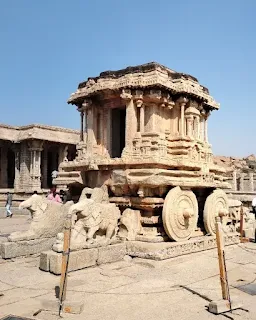The enigmatic Vittala Temple in Hampi and its melodic pillars are one such edifice that has captivated humans from the dawn of time. This temple, which is thought to be the center of Hampi's attractions, is a masterpiece of grandeur and architecture. Words cannot capture the splendor of this location. Pavilions, halls, and numerous additional temples are located inside the expansive compound of this temple.
Though science and belief are two distinct concepts, they may collide without cause. Scientific discoveries can sometimes encourage belief, although there are no hard and fast rules in this area. We occasionally witness phenomena that defy scientific explanations. The only thing that distinguishes them is a mystery.
Rama Raya, the chief minister of Vijayanagar, led the empire into the decisive battle of Talikota in 1565, where the united forces of the Muslim states of Bijapur, Ahmadnagar, and Golconda completely destroyed the capital of Vijayanagar.
India, a nation rich in culture and legacy, may be proud of a 5,000-year history. It was ruled by numerous kings from time to time, who established kingdoms and left a legacy that finally provided us with the blueprint for an ancient civilization. India received numerous magnificent buildings, regal forts, temples, and palaces as a result of its rich past, leaving us breathless at first sight.
All of these buildings astound us with their architecture and their complexity, but some also astound us with their enigmatic qualities. In India, there are locations that defy all known laws of physics and are only real because of a divine mystery or something else. Others disagree with those who say these are just myths. We have further information on the Vittala Temple's musical pillars along those lines.
During Devaraya II's reign in the 15th century, the temple was constructed. He was one of the Vijayanagara Empire's emperors. The temple, also known as Vijaya Vittala Temple, is devoted to Vittala and is considered to be an avatar of Lord Vishnu. According to mythology, Lord Vishnu in his Vittala avatar was the intended recipient of the temple, but when he discovered how magnificent it was, he decided to return to his simple dwelling in Pandharpur.
Beautiful stone constructions like the melodic pillars and the stone chariot can be found at the Vittala Temple. Both of these buildings reveal a great deal about the period's unparalleled craftsmanship. Despite attracting visitors from all around the world, this temple in Hampi is largely in disarray.
One of the most stunning and opulent temples in Hampi is the Vittala Temple. The skill of the artisans from the Vijayanagara Empire will astound you as soon as you enter the complex. The complex's structure is decorated with Dravidian architecture, which is complemented by ornate carvings.
The main hall, or Maha Mandapa, Devi Shrine, Kalyana Mantapa, Ranga Mantapa, Utsava Mantapa, and the very well-known stone chariot are significant constructions among the many others.
The south, north, and east of the Maha-four Mantapa's open halls are still intact. The western hall likely fell during the empire's capture. The Maha-beautifully mantapa's carved, enormous pillars are its main draw. The moniker "musical pillars" comes from the claim that tapping on these pillars produces a musical note. Vibes have their own musical tone despite not being a part of any regular musical scale. It is actually forbidden to tap the pillars since it attracts tourists who are enticed to do so repeatedly and needs to be conserved.
There are numerous statues of musicians on the walls of the eastern hall, commonly known as the musician's hall. Dancers, musicians, and drummers are all depicted in sculptures on the pillars that encircle the hall. Yalis, the fabled gigantic lions, are crowded into the southern hall. Each of these pillars' capitals is a superb example of some incredible sculptor work, with elaborate corbels that end in lotus buds.
The man-lion manifestation of Vishnu known as Narasimha is carved into the pillars that surround the northern hall. The one where Narshimah is seen killing Hiranyakashyap and Prahlada is shown on the other side in a praying position is the most notable.
With two gates on either side, the west is closed off and leads to the inner sanctum. Just within the inner sanctum, where an idol has been carved out, the ceilings bear sculptures in the shape of lotuses. The inner sanctum is surrounded by a constrained hallway. From this passageway, one can observe the exterior wall that is painted with Kumbha-Pankajas, which are actually displays of bodies with the heads of an elephant and a bull.
Rama Raya, the chief minister of Vijayanagar, led the empire into the decisive battle of Talikota in 1565, where the united forces of the Muslim states of Bijapur, Ahmadnagar, and Golconda completely destroyed the capital of Vijayanagar.











